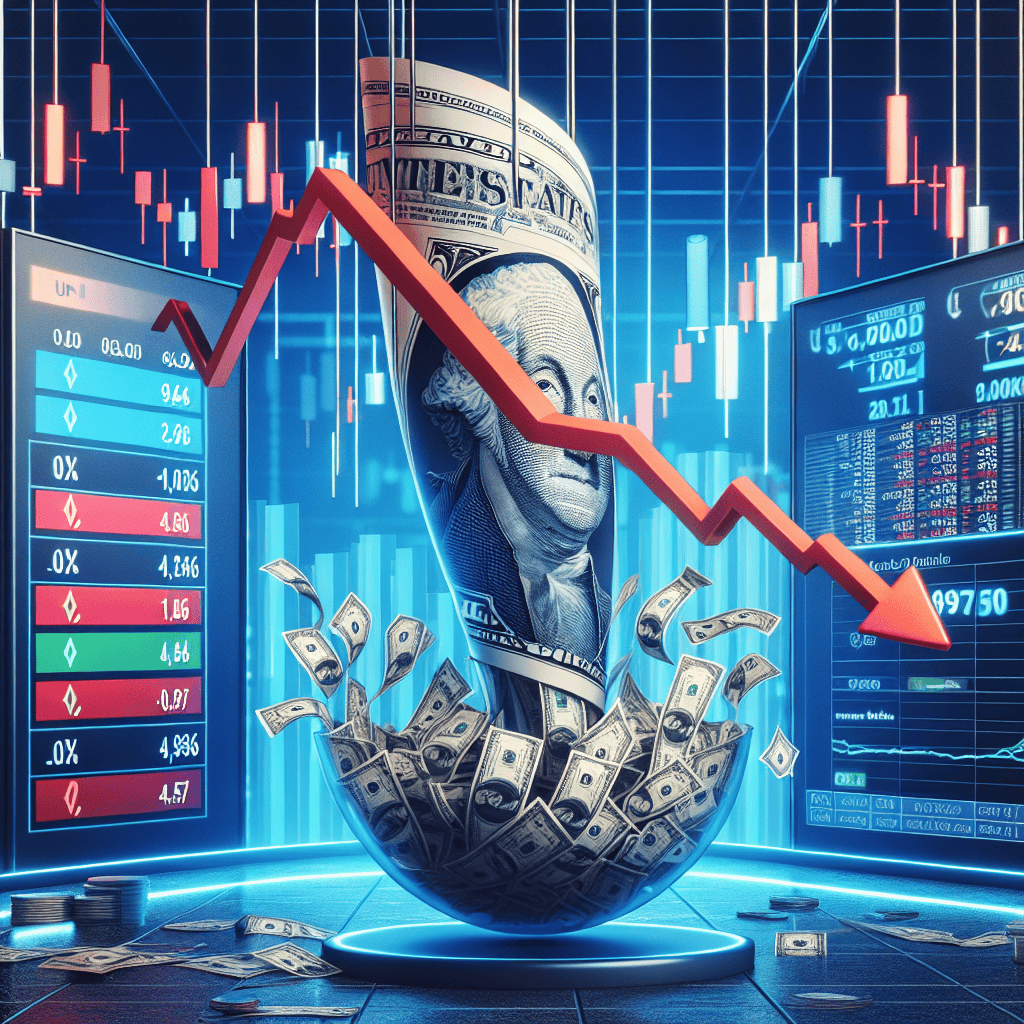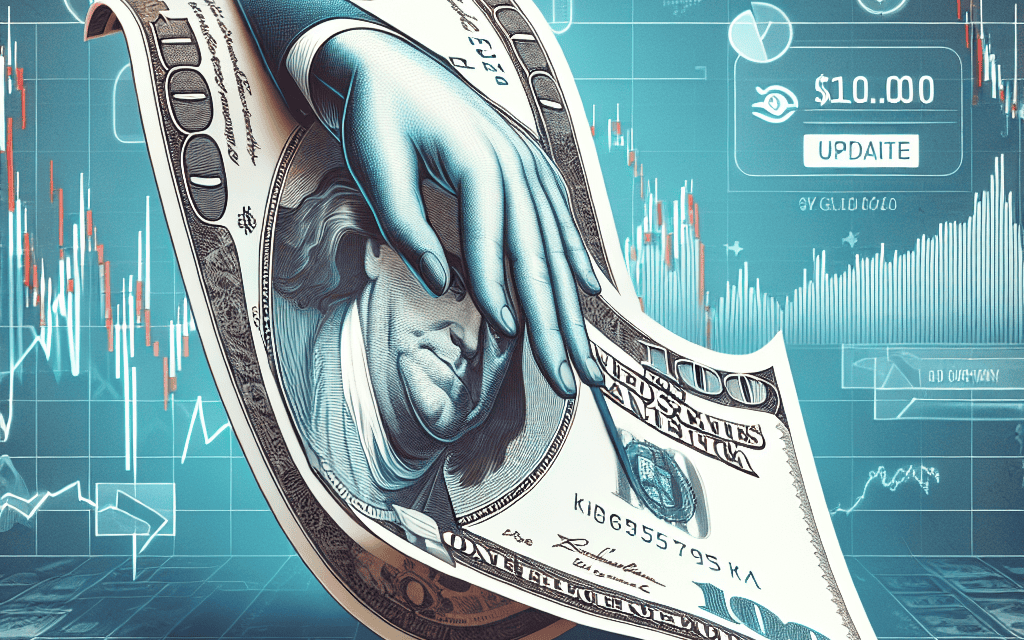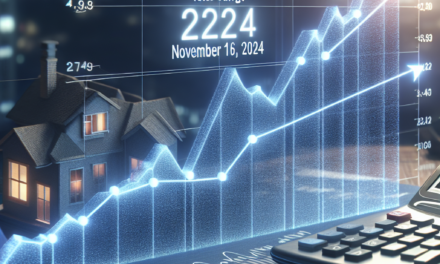“Market Jitters: Dollar Dips as US Election Tightens”
Introduction
The US dollar experienced a decline as the nation faced a tightly contested election, creating uncertainty in the financial markets. Investors closely monitored the evolving political landscape, which significantly influenced currency valuations and market sentiment. The fluctuating dollar reflected the broader economic implications of the election outcome, with potential shifts in fiscal and monetary policies at stake. As the race remained too close to call, market participants braced for potential volatility, seeking safe-haven assets and adjusting their portfolios in response to the unfolding electoral dynamics. This market update delves into the factors driving the dollar’s dip and the broader economic context surrounding the US election.
Impact Of US Election Uncertainty On The Dollar
The dollar’s recent dip in value can be attributed to the heightened uncertainty surrounding the tight US election race, a situation that has left investors and market participants on edge. As the election approaches, the lack of a clear frontrunner has introduced a significant degree of unpredictability into the financial markets. This uncertainty is reflected in the currency markets, where the dollar has experienced fluctuations as investors grapple with the potential outcomes and their implications for economic policy.
In times of political uncertainty, the dollar often becomes a focal point for investors seeking stability. However, the current election cycle has presented a unique set of challenges. The close race has led to concerns about potential delays in election results, contested outcomes, and the subsequent impact on fiscal and monetary policy. These factors have collectively contributed to a cautious approach among investors, who are wary of making significant moves until more clarity emerges.
Moreover, the dollar’s performance is intricately linked to expectations regarding future economic policies. A change in administration could lead to shifts in trade policies, tax regulations, and government spending, all of which have direct implications for the currency’s value. Investors are particularly attuned to the candidates’ differing stances on these issues, as they attempt to gauge the potential impact on the US economy and, by extension, the dollar.
Adding to the complexity is the global economic landscape, which remains fragile due to the ongoing effects of the COVID-19 pandemic. The pandemic has already exerted considerable pressure on the US economy, and the election’s outcome could either exacerbate or alleviate these challenges. For instance, a continuation of current policies might suggest a steady approach to economic recovery, while a shift in leadership could introduce new strategies that either bolster or hinder growth. This uncertainty further complicates the dollar’s trajectory, as investors weigh the potential for both domestic and international economic repercussions.
Furthermore, the Federal Reserve’s monetary policy plays a crucial role in shaping the dollar’s value. The central bank’s actions are closely monitored by market participants, who seek to understand how election results might influence future interest rate decisions and other monetary measures. A change in administration could lead to adjustments in the Fed’s approach, thereby affecting the dollar’s attractiveness as a safe-haven asset.
In light of these factors, it is evident that the dollar’s recent dip is not merely a reflection of short-term market sentiment but rather a response to a confluence of uncertainties that have emerged in the lead-up to the election. As investors navigate this complex environment, they are likely to remain cautious, opting for strategies that mitigate risk while awaiting more definitive election outcomes.
In conclusion, the tight US election race has introduced a level of uncertainty that has significantly impacted the dollar’s performance. The interplay between political developments, economic policies, and global conditions has created a challenging landscape for investors. As the election draws nearer, the dollar’s trajectory will continue to be influenced by these factors, underscoring the importance of closely monitoring political and economic developments in the coming weeks.
Historical Trends: How Elections Affect Currency Markets
The relationship between political events and financial markets has long been a subject of interest for economists and investors alike. In particular, the impact of U.S. presidential elections on currency markets, especially the U.S. dollar, has been a focal point of analysis. Historically, elections introduce a degree of uncertainty that can lead to fluctuations in currency values. As the world’s primary reserve currency, the U.S. dollar often experiences volatility during election periods, reflecting the market’s response to potential shifts in economic policy and geopolitical strategy.
To understand how elections affect currency markets, it is essential to consider the broader context of market psychology and investor behavior. During election cycles, investors tend to be cautious, often adopting a wait-and-see approach. This caution stems from the uncertainty surrounding potential changes in fiscal policy, trade agreements, and international relations, all of which can significantly influence the economic landscape. Consequently, this uncertainty can lead to increased volatility in the currency markets, as traders react to the latest polling data, debates, and policy announcements.
Historically, the U.S. dollar has shown varied responses to different election outcomes. For instance, when a candidate perceived as market-friendly is leading in the polls, the dollar may strengthen due to investor optimism about future economic policies. Conversely, if a candidate with protectionist or unconventional economic policies gains traction, the dollar might weaken as investors anticipate potential disruptions to trade and economic growth. This dynamic was evident in the 2016 election when the unexpected victory of Donald Trump led to a brief dip in the dollar, followed by a rally as markets adjusted to his pro-business agenda.
Moreover, the impact of elections on the dollar is not solely determined by the candidates’ economic policies. Broader geopolitical considerations also play a crucial role. For example, an election that signals a shift in foreign policy can affect international relations and trade partnerships, thereby influencing the dollar’s value. In this context, the market’s perception of a candidate’s ability to maintain stable international relations can be as significant as their domestic economic policies.
In addition to these factors, the role of the Federal Reserve cannot be overlooked. The central bank’s monetary policy decisions, particularly regarding interest rates, are closely watched by currency traders. During election periods, the Fed may adopt a more cautious stance, opting to maintain stability until the political landscape becomes clearer. This approach can further influence the dollar’s performance, as interest rate expectations are a key driver of currency values.
As we consider the current tight U.S. election race, it is evident that historical trends provide valuable insights into potential market movements. However, it is important to recognize that each election is unique, shaped by its own set of circumstances and challenges. While past patterns offer guidance, they do not guarantee future outcomes. Investors must remain vigilant, continuously assessing the evolving political and economic landscape to make informed decisions.
In conclusion, the interplay between U.S. elections and currency markets is complex and multifaceted. Historical trends highlight the significant impact that political events can have on the dollar, driven by factors such as market psychology, policy expectations, and geopolitical considerations. As the current election unfolds, understanding these dynamics will be crucial for investors seeking to navigate the uncertainties of the currency markets.
Strategies For Investors During Election-Induced Volatility
As the U.S. election race tightens, investors are closely monitoring the financial markets, particularly the fluctuations in the value of the U.S. dollar. Historically, election periods have been characterized by heightened volatility, and this year is no exception. The dollar’s recent dip reflects the uncertainty surrounding the election outcome, prompting investors to reassess their strategies in navigating this turbulent period. Understanding the dynamics at play and adopting informed strategies can help investors mitigate risks and capitalize on potential opportunities.
Firstly, it is crucial for investors to recognize that currency markets are highly sensitive to political developments. The dollar’s performance is often seen as a barometer of investor confidence in the U.S. economy and its political stability. As the election race narrows, the potential for policy shifts and changes in economic direction increases, leading to fluctuations in the dollar’s value. Consequently, investors should remain vigilant and stay informed about political developments, as these can have immediate and significant impacts on currency markets.
In light of the current volatility, diversification emerges as a key strategy for investors. By spreading investments across various asset classes and geographic regions, investors can reduce their exposure to currency risk. For instance, incorporating foreign equities or bonds into a portfolio can provide a hedge against a declining dollar. Additionally, investing in commodities such as gold, which traditionally holds its value during times of uncertainty, can offer further protection. Diversification not only helps in managing risk but also positions investors to benefit from potential gains in different markets.
Moreover, investors should consider employing hedging strategies to safeguard their portfolios against adverse currency movements. Utilizing financial instruments such as options and futures contracts can provide a buffer against unexpected shifts in the dollar’s value. These tools allow investors to lock in exchange rates or set predetermined prices for future transactions, thereby minimizing the impact of currency fluctuations on their investments. While hedging can incur additional costs, the protection it offers can be invaluable during periods of heightened volatility.
In addition to diversification and hedging, maintaining a long-term perspective is essential for investors navigating election-induced market volatility. Short-term market movements, while often dramatic, do not necessarily reflect the underlying fundamentals of the economy. By focusing on long-term investment goals and maintaining a disciplined approach, investors can avoid making impulsive decisions based on temporary market fluctuations. This strategy not only helps in weathering the storm of election-related volatility but also positions investors to capitalize on long-term growth opportunities.
Furthermore, staying informed and seeking professional advice can enhance an investor’s ability to make sound decisions during uncertain times. Financial advisors and market analysts can provide valuable insights into market trends and potential risks, helping investors to tailor their strategies accordingly. By leveraging expert knowledge and staying abreast of market developments, investors can better navigate the complexities of the current financial landscape.
In conclusion, the tight U.S. election race and the resulting dip in the dollar underscore the importance of strategic planning for investors. By embracing diversification, employing hedging strategies, maintaining a long-term perspective, and seeking professional guidance, investors can effectively manage the challenges posed by election-induced volatility. As the political landscape continues to evolve, these strategies will be instrumental in safeguarding investments and seizing opportunities in an ever-changing market environment.
Comparing The Dollar’s Performance In Past Tight Elections

The performance of the U.S. dollar during tight election races has historically been a subject of keen interest for investors and economists alike. As the current election cycle unfolds with a particularly close race, it is instructive to compare the dollar’s behavior in similar past scenarios. Historically, the dollar’s performance in tight elections has been influenced by a combination of market uncertainty, investor sentiment, and the anticipated economic policies of the candidates involved.
To begin with, examining the 2000 U.S. presidential election provides valuable insights. The contest between George W. Bush and Al Gore was one of the closest in American history, culminating in a protracted legal battle over Florida’s electoral votes. During this period of uncertainty, the dollar experienced significant volatility. Initially, the currency weakened as investors grappled with the potential for prolonged political instability. However, once the Supreme Court resolved the election in December, the dollar stabilized, reflecting a return to market confidence.
Similarly, the 2016 election between Donald Trump and Hillary Clinton offers another pertinent example. Leading up to the election, the dollar exhibited fluctuations as polls showed a tight race. The unexpected victory of Trump, coupled with his proposed economic policies, initially led to a surge in the dollar’s value. This was largely due to expectations of fiscal stimulus and tax reforms, which were anticipated to boost economic growth. However, as the political landscape evolved and uncertainties regarding trade policies emerged, the dollar’s strength was tested once again.
In contrast, the 1960 election between John F. Kennedy and Richard Nixon, though close, did not have as pronounced an impact on the dollar. At that time, the global financial system was underpinned by the Bretton Woods Agreement, which pegged currencies to the U.S. dollar, thereby limiting its volatility. Nonetheless, the election’s outcome did influence investor sentiment, as Kennedy’s New Frontier policies were expected to stimulate economic growth, albeit with a cautious approach to fiscal expansion.
Transitioning to the present, the current tight election race has similarly led to fluctuations in the dollar’s value. Investors are closely monitoring the candidates’ economic platforms, particularly their stances on fiscal policy, trade, and international relations. The uncertainty surrounding the election outcome has contributed to a dip in the dollar, as market participants weigh the potential implications for economic stability and growth.
Moreover, the global economic context in which this election is taking place adds another layer of complexity. The ongoing recovery from the COVID-19 pandemic, coupled with geopolitical tensions and inflationary pressures, has heightened market sensitivity to political developments. As a result, the dollar’s performance is not only a reflection of domestic political dynamics but also of broader global economic conditions.
In conclusion, the dollar’s behavior during tight U.S. election races is shaped by a confluence of factors, including political uncertainty, investor expectations, and the prevailing economic environment. By examining past elections, we can discern patterns that may offer guidance in understanding the current market dynamics. As the election unfolds, the dollar’s trajectory will continue to be closely watched, serving as a barometer of both domestic and international economic sentiment.
Global Market Reactions To US Election Developments
The global financial markets are closely monitoring the developments of the tight U.S. election race, with the dollar experiencing a notable dip as investors react to the unfolding political landscape. As the election results remain uncertain, market participants are grappling with the potential implications for economic policy and international relations. This uncertainty has led to increased volatility, with the dollar’s decline reflecting broader concerns about the future direction of U.S. fiscal and monetary policy.
In recent weeks, the dollar has been under pressure as investors weigh the potential outcomes of the election. The currency’s performance is often seen as a barometer of investor sentiment, and its current weakness suggests a cautious approach among market participants. The prospect of a contested election or a prolonged period of political uncertainty is contributing to this cautious sentiment, as investors seek to hedge against potential risks. Consequently, the dollar’s dip is not only a reflection of domestic political dynamics but also a signal of broader global market apprehensions.
Moreover, the dollar’s decline is having ripple effects across various asset classes. For instance, commodities such as gold and oil are experiencing fluctuations as investors adjust their positions in response to currency movements. Gold, often viewed as a safe-haven asset, has seen increased demand as the dollar weakens, highlighting the interconnectedness of currency markets and commodity prices. Similarly, oil prices are being influenced by the dollar’s trajectory, given that oil is priced in dollars globally. A weaker dollar can make oil cheaper for holders of other currencies, potentially boosting demand and impacting prices.
In addition to commodities, equity markets are also reacting to the dollar’s movements. U.S. stocks have shown mixed performance, with sectors sensitive to currency fluctuations experiencing heightened volatility. Companies with significant international exposure are particularly affected, as a weaker dollar can impact their earnings and competitiveness abroad. This dynamic underscores the complex interplay between currency markets and corporate performance, as businesses navigate the challenges posed by exchange rate fluctuations.
Furthermore, the dollar’s dip is prompting central banks and policymakers around the world to reassess their strategies. A weaker dollar can have significant implications for global trade and investment flows, influencing decisions on interest rates and monetary policy. Central banks in emerging markets, for example, may face pressure to adjust their policies to mitigate the impact of a weaker dollar on their economies. This highlights the far-reaching consequences of U.S. election developments on global economic stability and policy-making.
As the election race continues to unfold, market participants are closely watching for any signs of resolution or further uncertainty. The outcome of the election will likely have significant implications for the dollar’s trajectory and, by extension, global financial markets. Investors are particularly attuned to potential shifts in U.S. fiscal policy, trade relations, and regulatory frameworks, all of which could influence the dollar’s future performance.
In conclusion, the dollar’s dip amid the tight U.S. election race is a reflection of the broader uncertainty facing global markets. As investors navigate this complex landscape, the interplay between political developments and financial markets remains a key focus. The evolving situation underscores the importance of closely monitoring both domestic and international factors that could shape the future of the dollar and its impact on the global economy.
Analyzing The Correlation Between Political Events And Currency Fluctuations
The intricate relationship between political events and currency fluctuations is a subject of perennial interest to economists and investors alike. As the US election race tightens, the dollar has experienced a noticeable dip, prompting market analysts to examine the underlying causes and potential implications of this trend. Political events, particularly those as significant as a presidential election, often introduce a degree of uncertainty into financial markets. This uncertainty can lead to volatility, as investors react to the potential for changes in economic policy, trade agreements, and international relations. In the current scenario, the narrowing gap between candidates has heightened market sensitivity, leading to fluctuations in the value of the dollar.
Historically, currency markets have been sensitive to political developments, with the US dollar often serving as a barometer for investor sentiment. During periods of political stability, the dollar tends to strengthen, reflecting confidence in the continuity of economic policies. Conversely, when elections are closely contested, as is the case now, the potential for a shift in policy direction can lead to a depreciation of the currency. This is particularly true when candidates present starkly different economic agendas, as investors attempt to anticipate the impact of potential policy changes on the broader economy.
Moreover, the current election cycle is occurring against a backdrop of global economic uncertainty, further complicating the picture. The ongoing effects of the COVID-19 pandemic, coupled with geopolitical tensions and fluctuating commodity prices, have already created a challenging environment for currency markets. In such a context, the added uncertainty of a tight election race can exacerbate existing volatility, as market participants weigh the potential outcomes and their implications for economic recovery and growth.
In addition to domestic factors, international perceptions of the US political landscape also play a crucial role in currency valuation. The dollar is not only a national currency but also a global reserve currency, meaning that its value is influenced by international confidence in the US economy and its governance. A closely contested election can lead to concerns about potential policy gridlock or shifts in foreign policy, which in turn can affect international trade and investment flows. As a result, foreign investors may adjust their portfolios, leading to fluctuations in the dollar’s value.
It is also important to consider the role of central banks in this dynamic. The Federal Reserve, in particular, plays a pivotal role in managing monetary policy and stabilizing the economy. During periods of political uncertainty, the Fed may take measures to reassure markets, such as adjusting interest rates or implementing quantitative easing. These actions can influence currency values by affecting interest rate differentials and investor expectations. However, the Fed’s ability to act is often constrained by the broader economic context and the need to balance domestic and international considerations.
In conclusion, the correlation between political events and currency fluctuations is complex and multifaceted. As the US election race tightens, the dollar’s dip reflects a confluence of domestic and international factors, including investor uncertainty, global economic conditions, and central bank policies. Understanding these dynamics is crucial for market participants seeking to navigate the challenges of a volatile financial landscape. As the election unfolds, continued vigilance and analysis will be essential in anticipating and responding to the potential impacts on currency markets.
Expert Predictions: The Dollar’s Path Post-Election
As the United States approaches a pivotal election, the financial markets are closely monitoring the potential impacts on the dollar, which has recently experienced a dip amid the tight race. Experts are weighing in on the possible trajectories the dollar might take post-election, considering the various economic policies that could be implemented depending on the election’s outcome. The dollar’s recent decline can be attributed to the uncertainty surrounding the election, as investors are cautious about making significant moves until the political landscape becomes clearer. This uncertainty is compounded by the broader global economic environment, which is still grappling with the aftereffects of the pandemic and ongoing geopolitical tensions.
In the event of a clear and decisive election result, experts predict that the dollar could stabilize as market confidence is restored. A decisive outcome would likely lead to a more predictable policy environment, allowing investors to make informed decisions based on the anticipated economic strategies of the new administration. However, if the election results are contested or lead to a prolonged period of uncertainty, the dollar could face further volatility. This scenario would likely result in a flight to safety, with investors seeking refuge in traditionally stable assets such as gold or the Swiss franc.
Moreover, the policies of the incoming administration will play a crucial role in determining the dollar’s path. For instance, a government that prioritizes fiscal stimulus and infrastructure spending could lead to a short-term depreciation of the dollar due to increased government borrowing. However, such policies might also stimulate economic growth, potentially strengthening the dollar in the long run. Conversely, an administration focused on reducing the national debt and implementing austerity measures might bolster the dollar’s value in the short term, although it could also slow economic growth.
Additionally, the Federal Reserve’s monetary policy will be a significant factor influencing the dollar’s trajectory. The central bank’s approach to interest rates and quantitative easing will be closely watched by investors. A continuation of the current low-interest-rate environment could exert downward pressure on the dollar, as investors seek higher returns elsewhere. On the other hand, any indication of tightening monetary policy could lead to a strengthening of the dollar, as higher interest rates typically attract foreign investment.
Furthermore, global economic conditions will also impact the dollar’s future. The ongoing recovery from the pandemic, coupled with geopolitical developments such as trade negotiations and international conflicts, will influence investor sentiment and, consequently, the dollar’s value. A robust global economic recovery could lead to increased demand for US exports, supporting the dollar. However, any setbacks in the recovery process or escalating geopolitical tensions could have the opposite effect.
In conclusion, the dollar’s path post-election is contingent upon a multitude of factors, including the election outcome, the policies of the incoming administration, the Federal Reserve’s monetary stance, and global economic conditions. While the current dip reflects market uncertainty, the dollar’s future will depend on how these elements unfold in the coming months. Investors and policymakers alike will need to remain vigilant and adaptable as they navigate this complex and evolving landscape.
Q&A
1. **What is the main focus of the market update?**
– The market update focuses on the fluctuations of the US dollar amid a closely contested US election race.
2. **How is the US dollar performing in the market?**
– The US dollar is experiencing a dip in value as the election race remains tight.
3. **What are investors concerned about regarding the election?**
– Investors are concerned about the uncertainty and potential delays in determining the election outcome, which could impact market stability.
4. **How are other currencies reacting to the dollar’s dip?**
– Other major currencies, such as the euro and yen, are gaining strength against the dollar due to its decline.
5. **What impact does the election uncertainty have on the stock market?**
– The uncertainty surrounding the election is causing volatility in the stock market, with investors being cautious.
6. **Are there any safe-haven assets benefiting from the current market conditions?**
– Yes, traditional safe-haven assets like gold and government bonds are seeing increased demand as investors seek stability.
7. **What are analysts predicting for the dollar’s future performance?**
– Analysts suggest that the dollar may continue to face pressure until there is more clarity on the election results and potential policy changes.
Conclusion
The dollar’s decline amid a tightly contested US election reflects heightened market uncertainty and investor caution. As election results remain unclear, market participants are likely seeking safer assets, leading to fluctuations in currency values. This situation underscores the sensitivity of financial markets to political developments and the potential for volatility during periods of electoral uncertainty. Investors may continue to monitor the election closely, adjusting their strategies based on emerging outcomes and potential policy implications.





